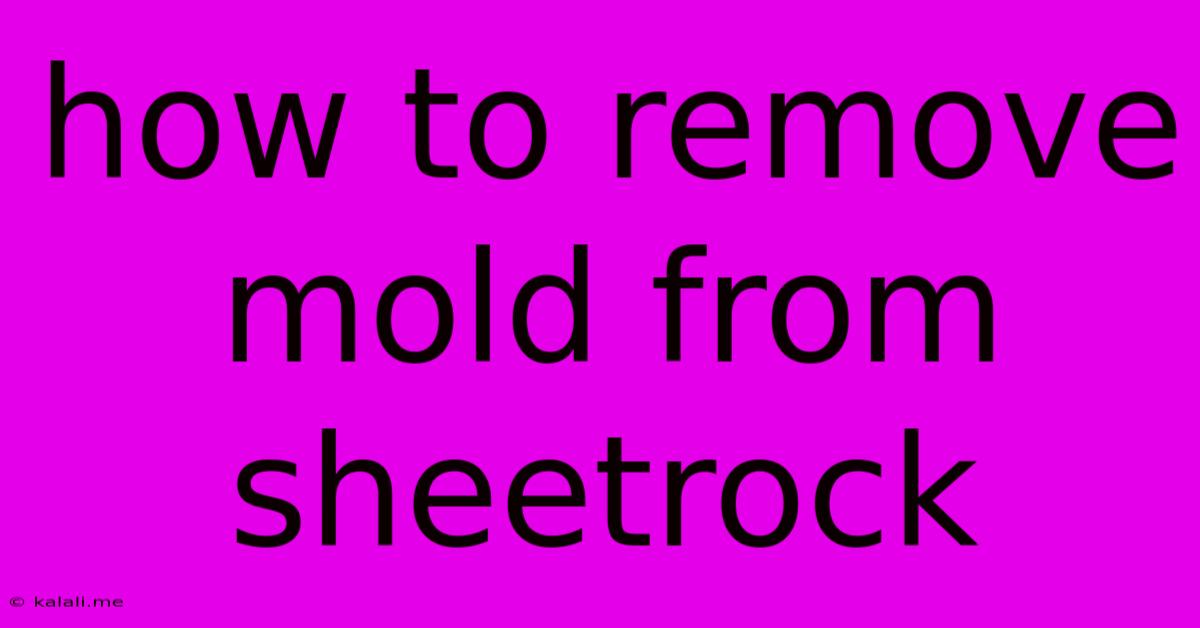How To Remove Mold From Sheetrock
Kalali
Jun 08, 2025 · 3 min read

Table of Contents
How to Remove Mold from Sheetrock: A Comprehensive Guide
Mold growth on sheetrock is a serious issue, impacting both the structural integrity of your home and the health of its occupants. This guide provides a step-by-step process on how to effectively remove mold from sheetrock, focusing on safety and thorough remediation. Ignoring mold can lead to serious health problems and extensive property damage, so addressing it promptly is crucial.
Understanding Mold Growth on Sheetrock
Mold thrives in damp, dark environments. Common causes of mold growth on sheetrock include water leaks from roofs, pipes, or appliances; high humidity levels; and poor ventilation. Identifying the source of the moisture is paramount before attempting any mold removal. Different types of mold exist, some more toxic than others, so proper identification and removal are key to preventing further issues. This often requires professional assessment, especially for large infestations.
Assessing the Extent of the Mold Infestation
Before you begin, accurately assess the extent of the problem. A small patch of mold might be manageable with DIY methods, but extensive mold growth often necessitates professional help. Consider these factors:
- Size of the affected area: Small, localized areas are easier to handle than widespread infestations.
- Type of mold: Some molds are more dangerous than others, requiring specialized equipment and safety precautions.
- Your own capabilities: If you're unsure about any aspect of the process, it's best to call in a professional mold remediation expert.
Safety First: Protecting Yourself
Mold removal involves exposure to potentially harmful spores. Always prioritize your safety:
- Wear protective gear: This includes an N95 respirator mask to filter out mold spores, gloves, eye protection, and long sleeves and pants to protect your skin.
- Ventilate the area: Open windows and doors to improve air circulation and help remove mold spores.
- Use appropriate cleaning solutions: Follow product instructions carefully and avoid mixing chemicals.
- Dispose of contaminated materials properly: Seal moldy sheetrock and other debris in plastic bags and dispose of them according to local regulations.
Removing Mold from Sheetrock: A Step-by-Step Guide (for small infestations)
For small, contained mold areas, you may be able to handle the remediation yourself. However, remember that if you're uncertain, professional help is always the safest option.
-
Kill the Mold: Begin by applying a solution of bleach and water (1 part bleach to 10 parts water) to the affected area. Let it sit for 10-15 minutes to kill the mold. Note: Bleach is effective for many molds but not all. Consider using a specialized mold killer if bleach is ineffective.
-
Scrub the Affected Area: Use a stiff brush to scrub the mold away. Make sure to remove all visible mold.
-
Rinse Thoroughly: Rinse the area with clean water to remove all traces of bleach or mold killer.
-
Dry Completely: Ensure the area is completely dry before repainting or replacing the sheetrock. Use fans to accelerate the drying process. This is crucial to prevent mold regrowth.
-
Repair or Replace: If the sheetrock is severely damaged, it will need replacement. If the damage is minor, you can sand and repaint the area once it is completely dry.
Preventing Future Mold Growth
Preventing mold growth is as important as removing it. Take these steps:
- Address moisture problems: Fix leaky pipes, roofs, or appliances promptly.
- Improve ventilation: Ensure proper ventilation in your home, especially in bathrooms and kitchens.
- Reduce humidity: Use dehumidifiers to lower humidity levels, especially in damp areas.
- Regular inspections: Regularly inspect your home for signs of mold growth. Early detection is key to preventing major problems.
Disclaimer: This article provides general guidance. For extensive or severe mold infestations, consult a professional mold remediation specialist. They have the expertise and equipment to safely and effectively address the problem, ensuring your safety and the long-term health of your home.
Latest Posts
Latest Posts
-
Epoxy On A Cracked Copper Pipe
Jun 09, 2025
-
What Is The Max Number Of Leaves Of A Bstree
Jun 09, 2025
-
What Does Kiss The Donkey Mean
Jun 09, 2025
-
Steering Wheel Shaking At 60 Mph
Jun 09, 2025
-
Monogram With Baskerville Bol 3 Letters
Jun 09, 2025
Related Post
Thank you for visiting our website which covers about How To Remove Mold From Sheetrock . We hope the information provided has been useful to you. Feel free to contact us if you have any questions or need further assistance. See you next time and don't miss to bookmark.